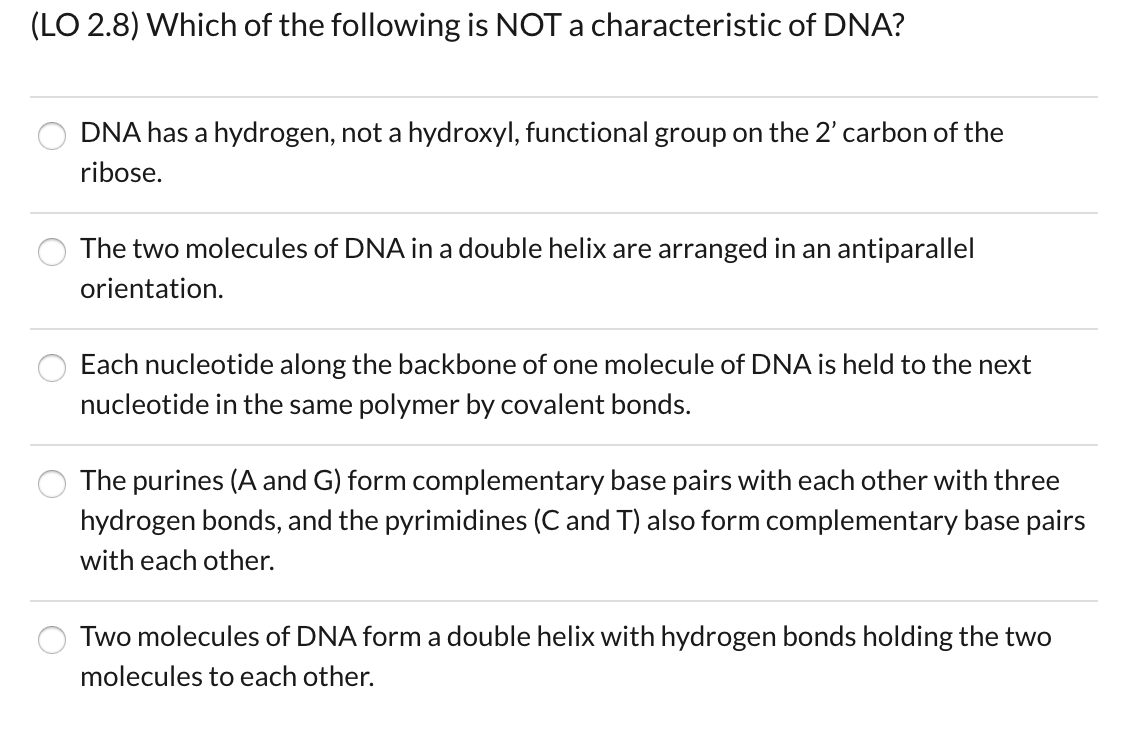(LO 2.8) Which of the following is NOT a characteristic of DNA? DNA has a hydrogen, not a hydroxyl, functional group on the 2' carbon of the ribose. The two molecules of DNA in a double helix are arranged in an antiparallel orientation Each nucleotide along the backbone of one molecule of DNA is held to the next nucleotide in the same polymer by covalent bonds. The purines (A and G) form complementary base pairs with each other with three hydrogen bonds, and the pyrimidines (C and T) also form complementary base pairs with each other. Two molecules of DNA form a double helix with hydrogen bonds holding the two molecules to each other.
(LO 2.8) Which of the following is NOT a characteristic of DNA? DNA has a hydrogen, not a hydroxyl, functional group on the 2' carbon of the ribose. The two molecules of DNA in a double helix are arranged in an antiparallel orientation Each nucleotide along the backbone of one molecule of DNA is held to the next nucleotide in the same polymer by covalent bonds. The purines (A and G) form complementary base pairs with each other with three hydrogen bonds, and the pyrimidines (C and T) also form complementary base pairs with each other. Two molecules of DNA form a double helix with hydrogen bonds holding the two molecules to each other.
Nutrition: Concepts and Controversies - Standalone book (MindTap Course List)
14th Edition
ISBN:9781305627994
Author:Frances Sizer, Ellie Whitney
Publisher:Frances Sizer, Ellie Whitney
Chapter6: The Proteins And Amino Acids
Section: Chapter Questions
Problem 4SC: Some segments of a protein strand coil, somewhat like a metal spring, because a. amino acids at...
Related questions
Question

Transcribed Image Text:(LO 2.8) Which of the following is NOT a characteristic of DNA?
DNA has a hydrogen, not a hydroxyl, functional group on the 2' carbon of the
ribose.
The two molecules of DNA in a double helix are arranged in an antiparallel
orientation
Each nucleotide along the backbone of one molecule of DNA is held to the next
nucleotide in the same polymer by covalent bonds.
The purines (A and G) form complementary base pairs with each other with three
hydrogen bonds, and the pyrimidines (C and T) also form complementary base pairs
with each other.
Two molecules of DNA form a double helix with hydrogen bonds holding the two
molecules to each other.
Expert Solution
This question has been solved!
Explore an expertly crafted, step-by-step solution for a thorough understanding of key concepts.
This is a popular solution!
Trending now
This is a popular solution!
Step by step
Solved in 3 steps

Recommended textbooks for you

Nutrition: Concepts and Controversies - Standalo…
Health & Nutrition
ISBN:
9781305627994
Author:
Frances Sizer, Ellie Whitney
Publisher:
Brooks Cole

Nutrition
Health & Nutrition
ISBN:
9781337906371
Author:
Sizer, Frances Sienkiewicz., WHITNEY, Ellie
Publisher:
Cengage Learning,

Biology: The Unity and Diversity of Life (MindTap…
Biology
ISBN:
9781305073951
Author:
Cecie Starr, Ralph Taggart, Christine Evers, Lisa Starr
Publisher:
Cengage Learning

Nutrition: Concepts and Controversies - Standalo…
Health & Nutrition
ISBN:
9781305627994
Author:
Frances Sizer, Ellie Whitney
Publisher:
Brooks Cole

Nutrition
Health & Nutrition
ISBN:
9781337906371
Author:
Sizer, Frances Sienkiewicz., WHITNEY, Ellie
Publisher:
Cengage Learning,

Biology: The Unity and Diversity of Life (MindTap…
Biology
ISBN:
9781305073951
Author:
Cecie Starr, Ralph Taggart, Christine Evers, Lisa Starr
Publisher:
Cengage Learning

Biology 2e
Biology
ISBN:
9781947172517
Author:
Matthew Douglas, Jung Choi, Mary Ann Clark
Publisher:
OpenStax

Anatomy & Physiology
Biology
ISBN:
9781938168130
Author:
Kelly A. Young, James A. Wise, Peter DeSaix, Dean H. Kruse, Brandon Poe, Eddie Johnson, Jody E. Johnson, Oksana Korol, J. Gordon Betts, Mark Womble
Publisher:
OpenStax College
